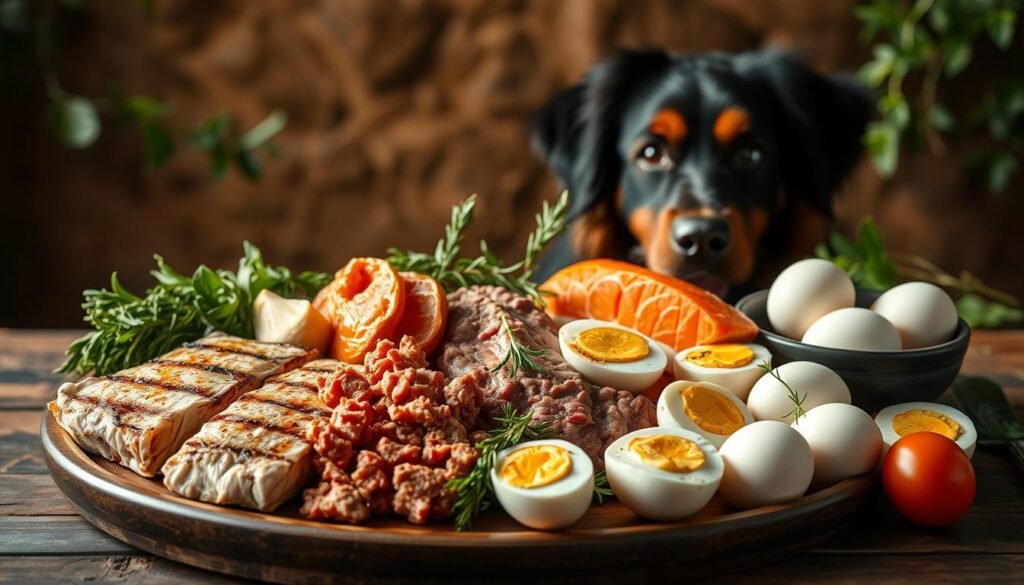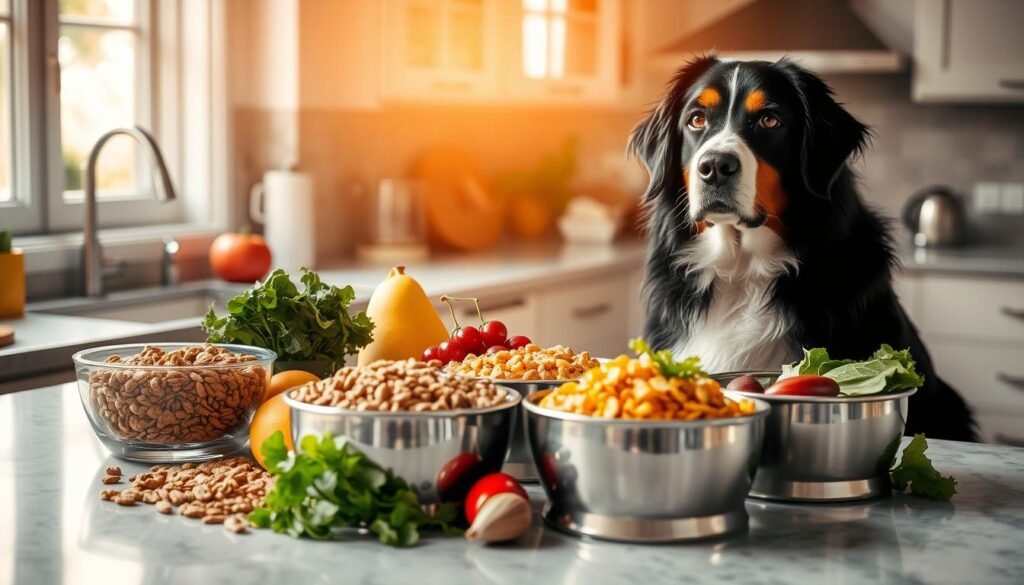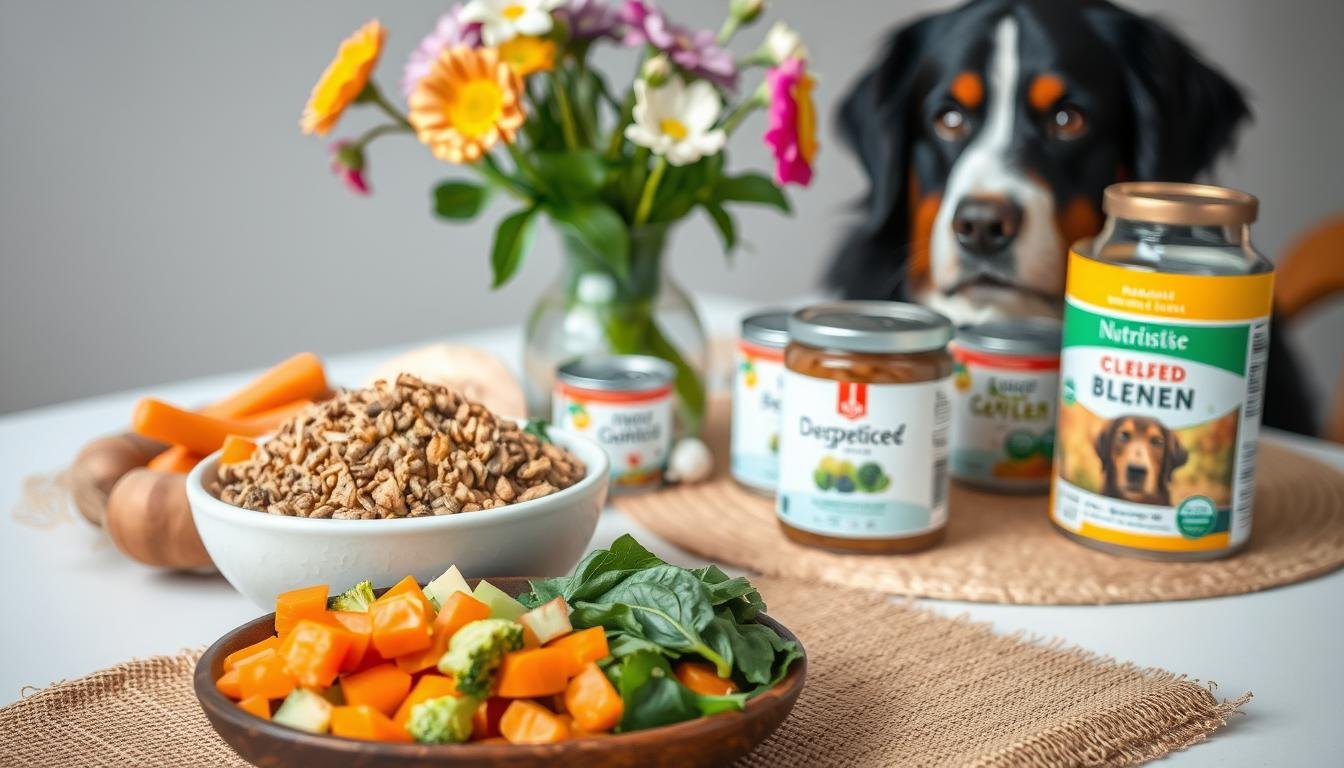There’s nothing quite like the joy of watching a fluffy companion bound across a field, their tail wagging like a metronome set to “pure happiness.” We’ve spent countless hours researching, testing, and refining meals for our gentle giants because every bite matters. These aren’t just pets—they’re family members with paws the size of dinner plates and hearts even bigger.
Feeding a large breed isn’t about filling a bowl. It’s about crafting a lifestyle. We’ve learned that what works for a Chihuahua could leave a 120-pound athlete sluggish or worse. Through trial, error, and consultation with experts, we’ve cracked the code on meals that keep tails wagging and joints moving smoothly.
Key Takeaways
- Balanced nutrition supports energy levels and longevity
- Portion control prevents weight-related health issues
- Specific formulas address common breed sensitivities
- Fresh ingredients enhance meal quality and enjoyment
- Regular vet consultations refine dietary choices over time
Our approach blends science with love—think of it as culinary caregiving. From kibble choices to homemade treats, we’ll walk you through strategies that have kept our own dogs thriving through seasons of play, work, and lazy Sunday snuggles.
Understanding the Nutritional Needs of Bernese Mountain Dogs
Feeding these majestic creatures isn’t rocket science—it’s harder. We treat every meal like a tailored suit: precise measurements, quality materials, and perfect fit. Their bodies require more than just calories; they need strategic fuel for mountain-sized adventures and couch-crashing marathons.
Importance of Balanced Nutrition
Imagine building a snowplow with toothpicks. That’s what happens when meals lack balance. Our approach combines:
- Premium proteins for lean muscle maintenance
- Smart carbs that burn like slow-burning logs
- Fats that lubricate joints and power brain function
We learned the hard way—skimp on quality, and you’ll see it in their energy dips and dull coats. Now we aim for meals that make vet visits boring (in the best way).
Key Vitamins and Minerals for Health
These nutrients are the secret sauce in their food bowl. Our checklist includes:
| Nutrient | Superpower | Top Sources |
|---|---|---|
| Calcium | Bone fortress builder | Yogurt, leafy greens |
| Vitamin E | Coat glossifier | Sunflower seeds, salmon |
| Zinc | Immune system booster | Beef, pumpkin seeds |
| Glucosamine | Joint ninja | Chicken feet, cartilage |
We mix commercial foods with fresh toppers—think of it as their daily multivitamin with wagging-tail approval. Because shiny coats and spring-loaded jumps don’t happen by accident.
High-Quality Protein Sources for Muscle Health

Protein isn’t just a menu item—it’s the foundation of every leap, pull, and tail wag. Our four-legged athletes need muscle-building fuel that keeps pace with their mountain-sized enthusiasm. We treat their bowls like blueprints for vitality.
Animal Proteins and Their Benefits
Not all proteins wear capes, but the right ones do superhero work. Through years of taste tests (approved by wagging critics), we’ve learned:
- Named meat sources beat vague “meal” labels every time
- Complete amino acid profiles prevent nutritional plot holes
- Digestibility determines whether food becomes energy or baggage
“The right proteins act like construction crews—repairing tissues while building strength.”
| Protein Source | Key Benefit | Best For |
|---|---|---|
| Chicken | Lean muscle maintenance | Active adults |
| Beef | Iron & zinc boost | Growing puppies |
| Fish | Omega-3 enrichment | Joint health |
| Eggs | Bioavailable nutrients | Senior vitality |
We rotate these power players to keep meals exciting and nutritionally diverse. It’s like giving their bodies a protein passport—stamps from different sources create well-rounded health.
Balancing Fats and Carbohydrates for Energy
Fueling these gentle giants requires more precision than mixing rocket fuel. We treat every meal as a nutritional blueprint where fats and carbs work in tandem—like synchronized swimmers powering through an Olympic routine.
Selecting Healthy Fats
Healthy fats aren’t villains in lab coats—they’re slick operators keeping coats glossy and joints supple. Our mealtime strategy includes:
- Omega-3 rich fish oil doubling as brain food and inflammation fighter
- Flaxseed for that show-ring coat shine
- Chicken fat delivering concentrated energy without the crash
We’ve learned that strategic fat sources act like premium gasoline—clean-burning fuel that powers adventures without gunking up the engine. Too little, and they sputter. Too much, and you’ve got a furry slug on your hands.
| Fat Source | Superpower | Ideal For |
|---|---|---|
| Salmon Oil | Joint support | Active adults |
| Coconut Oil | Metabolism boost | Weight management |
| Duck Fat | Palatability | Picky eaters |
Carbohydrates get their moment too—complex sources like oats and sweet potatoes provide slow-release energy. Think of them as the bassline in their favorite song: steady, reliable, and keeping everything moving forward. Our complete feeding guide shows how to mix these elements for tail-wagging results.
Getting this balance right transforms food into sustained vitality. It’s not just about filling bowls—it’s about crafting energy systems that power their adventures from sunrise hikes to midnight snack patrols.
Meal Frequency and Portion Control for Large Breeds

Timing meals for giant breeds isn’t just clockwork—it’s survival science. We treat every kibble portion like chess moves, strategically placed to outmaneuver health risks while maximizing tail wags.
Daily Feeding Schedules
Our approach makes airport traffic control look simple. Puppies under six months get fuel boosts every 2-3 hours—their tiny engines burn through calories faster than a wildfire. Here’s our battle-tested schedule:
| Age | Meals/Day | Portion Strategy |
|---|---|---|
| 0-6 months | 7-8 | Shot glass-sized servings |
| 6-12 months | 6-7 | Teacup portions |
| 1+ years | 5+ | Salad plate spreads |
Adults thrive on multiple small meals rather than feast-or-famine routines. This snack attack method keeps metabolisms buzzing without overwhelming their digestive systems. We learned this after one too many emergency vet visits for bloated bellies.
Portion control? We’ve turned it into an art form. Instead of rigid charts, we use the rib test—if we can’t feel their ribs through winter coats, we adjust amounts faster than a barista changes espresso orders. Activity levels and weather patterns dictate our daily calculations more than any generic guideline ever could.
“Frequent feeding isn’t pampering—it’s preventive medicine for deep-chested breeds.”
Remember: food bowls aren’t cruise ship buffets. Our golden rule? Enough to nourish, never enough to bulge. Because nothing ruins playtime faster than a dog panting “I regret that third helping.”
Rotational Feeding: Enhancing Diet Diversity

Variety isn’t just for human taste buds—it’s a gut health revolution for our four-legged friends. We treat meal rotations like culinary cross-training, building digestive resilience through strategic menu changes. This approach keeps their systems adaptable, like having a Swiss Army knife for nutrition.
Preventing Ingredient Sensitivities
Static menus create picky eaters and sensitive stomachs. Our rotation strategy follows three rules:
- Switch protein sources every 2-3 months
- Alternate between poultry, fish, and novel meats
- Blend commercial formulas with fresh toppers
Think of it as immune system boot camp. By exposing our Berners to diverse ingredients early, we’re essentially vaccinating their guts against future intolerances. It’s not chaos—it’s calculated exposure therapy with wagging tails as feedback.
| Static Diet Risks | Rotational Benefits |
|---|---|
| Monotonous microbiome | Gut biodiversity |
| Recall vulnerability | Menu flexibility |
| Nutrient gaps | Balanced intake |
We transition new foods over 7-10 days, mixing old and new kibble like DJs blending tracks. This gradual shift prevents digestive mutinies while keeping meals exciting. The result? Companions who approach dinner like food critics at a Michelin-starred tasting menu.
Puppy, Adult, and Senior Dietary Considerations

Nutritional needs shift like seasons—what fuels a bouncing puppy could weigh down a wise elder. We approach life stages as distinct culinary eras, each demanding its own recipe for thriving. Think of it as meal-planning through time: puppyhood’s explosive growth, adulthood’s steady burn, and senior years’ graceful glide.
Adjusting for Growth and Aging
Puppies aren’t miniature adults—they’re nutritional tornadoes. Our strategy focuses on controlled expansion, using precise calcium ratios to prevent skeletal issues. Too much protein turns growth spurts into health hazards, so we measure kibble like lab technicians mixing rocket fuel.
Adults hit their stride with maintenance-focused meals. This phase lets us balance energy input with output, like accountants reconciling a joy-filled ledger. We prioritize muscle preservation and joint support, keeping tails wagging through hikes and sofa marathons.
| Life Stage | Focus | Key Adjustments |
|---|---|---|
| Puppy (0-18mo) | Controlled growth | 25% protein, 1.5% calcium |
| Adult (1.5-7yrs) | Energy balance | 20% protein, glucosamine-rich |
| Senior (7+yrs) | Comfort & longevity | 18% protein, added fiber |
Seniors become gourmet clients needing delicate care. We swap calories for fiber, add joint-nurturing supplements, and choose digestible proteins. Their bowls transform into anti-aging elixirs—less about quantity, more about targeted nourishment.
“Feeding seniors isn’t about restriction—it’s strategic support for their best golden years.”
Three life stages, three nutritional blueprints. By honoring these shifts, we craft diets that evolve alongside our companions—from clumsy first steps to dignified sunset strolls.
Managing Food Allergies and Sensitivities
When your furry friend starts scratching like a DJ at a rave, it’s time to play detective. Food sensitivities turn mealtime into a mystery novel where we’re both sleuth and suspect. Our Bernese Mountain companions might hide their discomfort behind wagging tails, but we’ve become experts at decoding their silent signals.
We’ve learned to spot clues like obsessive paw-licking or sudden digestive rebellions—red flags waving ‘investigate my bowl!’ Our approach? Become elimination diet ninjas, stripping meals down to basics before reintroducing ingredients one by one.
Novel proteins become our secret weapons—venison, duck, or kangaroo meals that their systems haven’t labeled as public enemies. Limited-ingredient formulas act like nutritional reset buttons, giving sensitive stomachs a fresh start.
Here’s the plot twist: allergies can strike veterans of the same food for years. That’s why we keep food journals like FBI case files, tracking every snack and reaction. Working with our vet, we’ve turned mealtime into allergy-busting missions.
The payoff? Less scratching, more playing—because every dog deserves a life where their biggest worry is which sunbeam to nap in.




